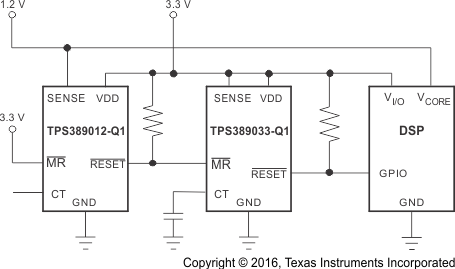SBVS303B March 2017 – February 2018 TPS3890-Q1
PRODUCTION DATA.
- 1 Features
- 2 Applications
- 3 Description
- 4 Revision History
- 5 Device Comparison Table
- 6 Pin Configuration and Functions
- 7 Specifications
- 8 Detailed Description
- 9 Application and Implementation
- 10Power Supply Recommendations
- 11Layout
- 12Device and Documentation Support
- 13Mechanical, Packaging, and Orderable Information
Package Options
Mechanical Data (Package|Pins)
- DSE|6
Thermal pad, mechanical data (Package|Pins)
Orderable Information
8.3.2 Manual Reset (MR) Input
The manual reset (MR) input allows a processor or other logic circuits to initiate a reset. A logic low on MR causes RESET to assert. After MR returns to a logic high and SENSE is above VITP, RESET is deasserted after the user-defined reset delay. If MR is not controlled externally, then MR must be connected to VDD. Note that if the logic signal driving MR is not greater than or equal to VDD, then some additional current flows into VDD and out of MR and the difference is apparent when comparing Figure 8 and Figure 9.
Figure 23 shows how MR can be used to monitor multiple system voltages when only a single CT capacitor is needed to set the RESET delay time.
 Figure 23. Using MR to Monitor Multiple System Voltages
Figure 23. Using MR to Monitor Multiple System Voltages